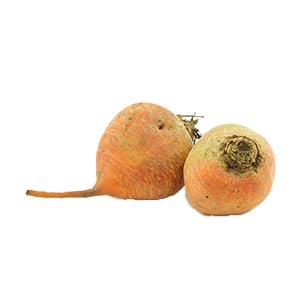Turnip

Turnip
Brassica rapa subsp. rapa
Plant family
Crucifers (Brassicaceae)
Cultivation Break
3 Years
Season Overview
Sowing
Harvest
Harvest
J
F
M
A
M
J
J
A
S
O
N
D
1ST YEAR
2ND YEAR
Details
Light requirement
Sunny
Water requirement
Moist
Soil
Medium (loamy)
Nutrient requirement
Medium
Dark germinator
Germination temperature
12 - 20 °C (Degrees Celsius)
Plant distance
30 cm
Row spacing
50 cm
Seeding depth
1.5 cm
Instructions
The season for this plant is over. The following instructions are for the next season.
Beginning of March
Sowing
End of March
Thinning
End of March
Weeding
Every two Weeks
Description
The turnip (Brassica rapa subsp. rapa var. majalis) is an ancient vegetable species with edible root. It is a special form of the edible turnip.
Origin:
Unidentified; Possibly from eastern Afghanistan, western Pakistan, or the Mediterranean.
Growing tips
Sowing can be in March, or for late harvest in July and August. Plenty of light and good air circulation will help the plant grow. Keep turnips weed-free and water them regularly during the growing season. Beets can be harvested 6-8 weeks after sowing, and the beets should be no more than 10 inches in diameter. The smaller they are, the more tender they are in taste. You can eat both the turnip and its leaves. Simply turn the largest tubers out of the soil, which you may have loosened a bit on the sides with a spade beforehand. Let the smaller tubers continue to grow.
Companion Plants
Bean ((Scarlet) runner bean)
Bean (Broad bean / Faba bean / Field bean)
Bean (Dwarf bean)
Bean (Hyacinth bean / Lablab-bean)
Bean (Runner bean)
Borage
Celery (Celery)
Celery (Leaf celery / Chinese celery)
Chard
Common marigold
Coriander / Cilantro
Dill
Lettuce (Common chicory)
Lettuce (Endive / Escarole / Erisée)
Lettuce (Lamb's lettuce)
Lettuce (Lettuce)
Lettuce (Puntarelle / Cicoria di catalogna / Cicoria asparago)
Lettuce (Radicchio / Italian chicory)
Lettuce (Sugar loaf)
Pea
Soybean
Spinach (Summer)
Spinach (Winter)
Antagonistic Plants
Abessinischer Kohl / Äthiopischer Senf
Arugula / Rocket
Broccoli
Broccoli raab / Stem cabbage / Cima di rapa
Brussels sprouts
Cabbage (Cabbage)
Cabbage (Pointed cabbage)
Cabbage (red cabbage)
Cabbage (Savoy cabbage)
Cauliflower
Chives
Collard greens
Collard greens (Kale)
Collard greens (Tuscan kale / Dinosaur kale / Palm tree kale)
Fennel
Florence fennel / Finocchio
Garlic
Gemüsekohl - Flower Sprouts / Kohlröschen
Gemüsekohl - Futterkohl
Gemüsekohl - Kai-Lan / Chinesischer Brokkoli
Gemüsekohl - Rippenkohl / Portugiesischer Kohl
Gemüsekohl - Wildkohl / Urkohl
Horseradish
Jerusalem artichoke / Topinambur
Kohlrabi / German turnip / Turnip cabbage
Leeks
Meerkohle
Napa cabbage / Chinese cabbage
Oil radish / Fodder radish
Onion
Pak Choi
Radish
Radishes
Raps
Raps - Scheerkohl / Sibirischer Kohl
Rosemary
Rutabaga / Swedish turnip
Diseases
Downy mildew
Root Rot
Club root of cabbage
Pests
Land snails
Carrot fly
Cabbage heart midge
Cutworms
Aphids
Cabbage white
Flea beetles
Cabbage fly
White fly
Wireworms
Voles